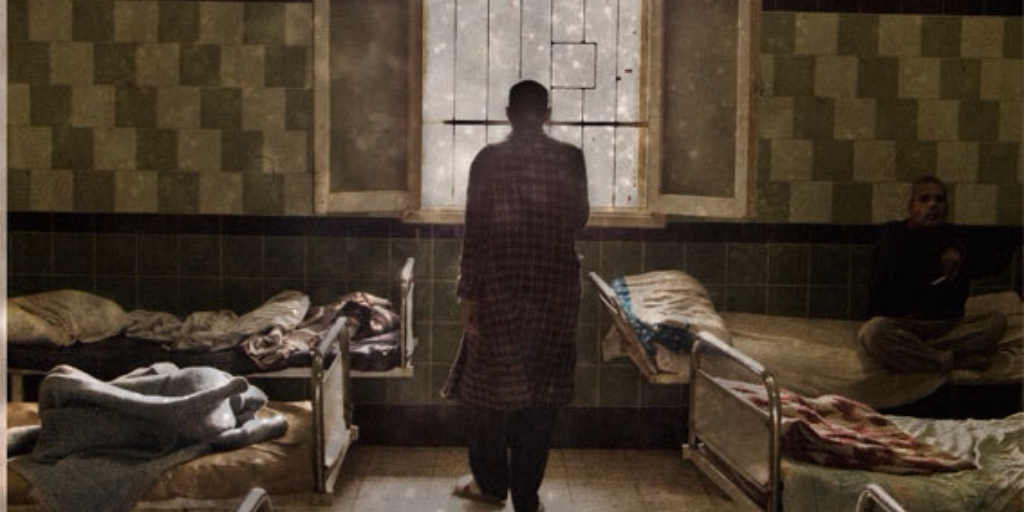Community mental health approaches can tackle Egypt’s psychiatric problems, yet the reliance on mental health hospitals is not only solidifying stigma but also hindering access to mental health services.
On the 25th of January 2011, as Egyptian pro-democracy protestors marched towards Tahrir Square hoping to incite political change, another extraordinary scene of communal resilience was taking place elsewhere in the country. In the district of Kafr al Dawar, some 23 kilometers away from Alexandria, the local commune at the village of Kobania Abu Qir, had gathered to inaugurate Egypt’s first and only mental health center.
“It was very special. This was the first time that those suffering from mental illness, their families, and community leaders, including the governor, the church priest, the local imam, the school headmaster and traditional healers had come together to decide and get involved with how mental health care could be provided in the community,” says Dr. Eman Souror, who has dedicated a lifetime towards working on alternative approaches to mental health care in Egypt.
The former international officer at the Mental Health Secretariat and the lead psychiatrist who launched the center as part of an Egyptian-Italian public initiative, Sorour was finally able to witness Egypt taking its first step towards transferring mental health services from mostly urban-based psychiatric hospitals to community-centered treatment.
Named after the revolutionary psychiatrist Franco Basaglia, whose reform and legislation in the late 70s led to the closure of psychiatric asylums in Italy, the center integrates district-level, public family health units and the closest mental health hospital of Maamura in Alexandria, offering a full range of mental health services. These treatments not only take place within the community but the model behind the center actually shies away from relying primarily on psychiatric hospital-based medical care.
Sahar, a 38-year-old single mother from Kafr al Dawar, suffers from acute depression. In 2011, she got divorced and had lost her minimum wage job at a textile factory. Having moved back with her family with no prospects and a child to raise, Sahar started suffering from extreme withdrawal and anxiety, causing physical inability to cope with her changed circumstance – a time she remembers as the “darkest phase” of her life. Confused, she would trap herself in her room and, spending days in isolation, would question her tormented mind. While knowing her life had taken a turn for the worse, yet still unable to find the source of her helplessness, she admitted herself to the Maamura psychiatric hospital in Alexandria. Reluctant to get hospitalized, yet pressured by her family and deteriorating condition, she checked in knowing that mental hospitals were considered to be only for the deranged.
“I was forced to take injections overnight and I suddenly found myself becoming delirious and out of control,” she says, recalling her short stint at the hospital. “I became violent. I was breaking things, screaming, and in an act of rage started pulling my hair out.”
Sahar had never suffered such extreme behavior before and realized that she could not be cured in a hospital that relied solely on medication; the next morning, she insisted on being checked out.
As one of the first patients to receive care at the community mental health center, today, she realizes how beneficial her treatment plan is. It not only includes medication, but also group therapy and individual counseling.
“My family at first did not understand my depression, mostly because I didn’t,” says Sahar. Today, due to the services provided at the center, her family not only understands her illness but is also better equipped to manage her depressive episodes.
In 2012, the Ministry of Health and Population’s register for psychiatric services listed the Franco Basaglia Center as Egypt’s first active mental health community center, which, until today, is managed and staffed by publicly employed primary care physicians.
The facility, which is minutes away from her home, has a strong referral system linked with psychologists from Maamura hospital that follow up with acute cases, hospitalizing patients only if need be. The model is exceptional in bridging a treatment gap and helps Sahar access mental health services while staying within her community. This model not only reduces prospects of exclusion and isolation from society but also provides those who are mentally ill with a safe space in which they are not “patients” but instead “members” of a center in charge of providing mental health care.
In the first 15 months after its opening, 365 patients, along with Sahar, had benefited from the community approach adopted in Kafr al Dawar. Unfortunately, despite the evident need of such services, plans to expand and roll out the model in five other governorates have yet to be implemented and there remains only one community mental health center of its kind in the country.
Traditionally, training given to psychiatrists and nurses has focused on transmitting experiential medical knowledge to equip doctors to treat patients inside Egypt’s 18, largely city-based, mental health hospitals. A meager 2 percent of Egypt’s national health budget is set aside for mental healthcare, with 70 percent of the funding spent on psychiatric hospitals. These hospitals, which in total have a bed capacity for no more than 7,000 patients, fall far below what is required. A pre-revolution survey in 2009 notes that at least 17 percent of the Egyptian population suffers from a mental disorder. That means that, out of a total population of 76.78 million at the time, around 13 million people in Egypt suffer from ailments ranging from depression and anxiety to schizophrenia and substance abuse.
More concerning, however, is that Egypt has a serious brain drain in its mental health workforce. According to the WHO Mental Health Atlas, the country currently has one psychiatrist available per 100,000 people. In this context, the Franco Basaglia center provides an alternative model by integrating mental health services within primary health care units at the district level. Simply put, the community model allows for mental health care professionals who would traditionally be concentrated in one hospital to instead spread out within the local population for follow-ups and training of primary care health workers, thereby covering more patients.
“We trained a multi-professional team of psychiatrists and nurses of the district to supervise and train non-specialist individuals and care-providers within the community,” says Sorour, adding that “they collectively helped with detection, diagnosis, treatment and monitoring of individuals with mental disorders.”
This task shifting showed positive results, providing an effective response to the mismatch between needs and resources that plagues access to mental healthcare in Egypt today.
Egypt’s Mental Asylums – Recovery Centers or Homeless Shelters?
Mental illness remains one of the darkest taboos in Egyptian society. Ashamed and embarrassed, those who seek help are subjected to routine scrutiny and abuse from society, causing the stigma to catalyze the plight of innumerous Egyptians who shun the prospect of receiving care altogether. Today, merely the name “Abbasiya” – Egypt’s oldest psychiatric hospital and asylum in Cairo – has become synonymous with the proverbial notion of a “madhouse” from which there is no return. Formerly the Khedive’s royal palace, which was converted into an asylum in 1883 under the British protectorate, the Abbasiya Mental Hospital, overlooking Salah Salem, is a living relic of a time when the mentally ill were considered criminals that ought to be locked up – not necessarily to be treated but to be kept from the public.
In part, this cultural perception of the mentally ill being associated with the locking up of the “insane” is due to the legacy of Egypt’s adoption of the western asylum system in the late 19th century. Setting a precedent, which segregated patients from their communities, the discourse around mental health at the time assumed that, “if you suffered from mental illness, it was pretty much for life and once you were admitted to the hospital it did not require any further checks,” says Dr. Nasser Loza, former Secretary-General of the Mental Health Secretariat.
The practices of the asylum model not only entailed social exclusion but also severe human rights abuse, as patients did not have any say over their admission to these facilities or choice and consent to treatment.
The accompanying legislation in Egypt, first introduced in 1944, also did not guarantee the protection of patient rights. For those in need of psychiatric attention, the 1944 law had no provision for consensual treatment; it was not essential for doctors to inform either the patient or their families of the risks, effects and nature of their method of treatment.
The gradual acceptance of mental illness within the larger health agenda, promoting patient rights with legislative decree took more than 60 years to materialize in Egypt. From 2006 to 2011, Loza opened up Egypt’s psychiatric hospitals to public scrutiny and his push for reform led to the 2009 Mental Health Act. Drastically better than its predecessor, the new legislation protected patients’ rights in institutions, curtailed the length of stay and required consent of treatment.
“On my first day at the job [as secretary-general], the head of security came into my office with a smashed camera in his hand and a terrified looking student of mass [communication] whom he had detained,” recalls Loza while laughing at the absurdity of how closed off Abbasiya had become to the public. “For one thing, I apologized to the student and we managed the situation, but you know I couldn’t blame the security guard because there was this culture that no one must come in, and of course that’s totally unnecessary.”
The opening up of psychiatric institutions to civil society, media, journalists and the general public during Loza’s time was part of a plan to change the public perception of mental health in Egypt. As the former secretary-general explains, “bringing the community inside mental institutions is a great thing but bringing the patients out to the community was much more important.”
While there were serious efforts made during Loza’s tenure to open up psychiatric hospitals such as Abbasiya to the media, today, access remains restricted. Despite Egyptian Streets submitting official requests and following up with the relevant authorities asking for access to Abbasiya, the hospital refused to allow this reporter to enter the institution, opting instead to keep it closed off from the public eye.
It is no secret, however, that Abbassiya, like many mental health hospitals in Egypt and the region today, has an ongoing problem with patients overstaying. Even after treatment, due to the stigma associated with those who are mentally ill, families who check in their relatives against their will cut ties and abandon them at hospitals. For many patients who have been living at Abbasiya for over 15 or 20 years, the hospital has now become their home – a shelter to live free from society’s imposed stigma.
“When the patient is treated, families refuse to take them back, with many asking for guarantees that the patient will not have a relapse,” says a psychiatrist from Abbasiya, who spoke to Egyptian Streets on the condition of anonymity. “Sometimes families who reluctantly take patients back make the situation even worse by intentionally keeping the medication from the patients so that when the next violent episode takes place they have a reason to send their relatives back to the hospital. It’s a vicious cycle.”
Owing to the painful awareness that those patients who are completely abandoned by their families are at a high risk of homelessness if kicked out, Abbassiya has formally initiated various recreational activities and provided minimal jobs for those who have adopted the hospital as their permanent home.
The overstaying of patients is not only reflective of problematic societal attitudes towards mental illness but is also a source of burden on the hospital’s capacity in which psychiatrists need to attend to patients on a one-to-one basis.
“On some days I see 30 patients in four hours. There can be no therapeutic relationship that can be built within the asylum system. All I do is spot the diagnosis and prescribe medication. Now you tell me – how can I provide quality care?” asks the psychiatrist from Abbasiya. The strain on the hospital’s human resources does not only affect the quality of care provided by physicians overwhelmed by their work but also hampers their potential efforts to reintegrate patients back into society.
Money Matters
Egypt is also struggling towards financing the integration of mental health services into primary health care and the model behind projects like the Franco Basaglia Center remains confined and unreplicated.
Integrating mental health services in primary health care gradually has gained a footing in Egypt with the support of local and international nonprofit organizations. Launched in 2005 and financed by the Drosos Foundation and Médicins du Monde, “improving access to mental health services among most at risk populations in Greater Cairo” is a three-year project implemented in partnership with the Ministry of Health and four Egyptian NGOs providing psychosocial services to marginalized groups. The program is supporting existing ministry efforts to merge mental health services into primary health care by providing training on mental health to doctors, nurses and social workers in nine primary health centers in the Greater Cairo and Giza governorates.
Indeed, the project is bringing Egypt one-step closer to providing improved mental health services to communities. Yet, it remains to be seen whether the pilot program, upon completion, will provide replicable practices for the remaining 5,314 primary healthcare centers in Egypt. The likelihood of yet another initiative aimed at improving the access to mental health services becoming overshadowed by the country’s centralized reliance on psychiatric hospitals as the main service providers for mental health care remains a big question for policy makers.
Dr. Khalid Saeed, regional advisor for mental health in the WHO, cautions that “the task of shifting from institutional to community-based models of care is costly, as provisions have to be made for transitional funding.” Egypt, like other countries in the region, needs to start calculating its bridge funding required for implementing such models, he says.
“If transitional resource allocation for decentralizing and transferring patients from psychiatric hospitals back into society is not in place, the chances of one service closing and the other not being in place remain. The transition to alternate mental health models has to be done gradually and in tandem.”
There is a popular belief among many psychologists that community health service is not as costly compared to resources required in other medical fields.
“The psychiatric profession which focuses on therapy and prescription of medicine, does not rely heavily on technological investment such as surgical tools, for instance,” says Sorour. In Egypt, where there is a significant human resource shortage of mental health professionals, a community approach will also serve to cut costs compared to the one-to-one consultation currently offered at psychiatric hospitals. Yet, transitional costs and “good quality interventions” cost the same, and in some cases have proved to be more costly than existing services, says Saeed. The capital costs alone for setting up the Franco Basaglia Center amounted to USD 73,000 – a whopping total for a country whose total mental health expenditure is equivalent to about USD 2.4 million in pre-float terms.
The costs attached to the transitioning period and developing integration programs may seem daunting at first sight, casting doubts on the efficacy of allocating resources to such initiatives. Yet, there is a lot to gain. Bringing mental health care to the community increases access for those in need while simultaneously alleviating the burden of psychiatric hospitals not only with problems arising from patient overstay but also with providing quality care that is both personalized and dignified.
Furthermore, the longer a person stays in the hospital, the more challenging it is for them to reintegrate into and become a productive member of society, meaning hospitals are unwittingly doing more harm than good by allowing patients to overstay.
“Psychiatric hospitals mainly emphasize on providing treatment by giving medication and having the patients gain insight to their situation. But the concept that you have to wait for the patient to gain insight before they are permitted to re-engage with their lives is disastrous. People have better outcomes if they’re engaged in society, if they are connecting with lives that they had prior to the hospitalization, if they feel that they are doing something meaningful,” says Dr. Mona Amer.
Egypt has to take a long, hard look at its current model of mental health care to identify the necessary steps to create long-term solutions for mental health. Although initial costs and efforts may be daunting, an overhaul of the system – if done right – can save the country a significant amount of money, while still providing quality care for Egypt’s mentally ill.
Additional reporting by Salma El-Saeed







Comment (1)
[…] http://egyptianstreets.com/2016/12/13/are-psychiatric-hospitals-in-egypt-hurting-mental-health-care/ […]